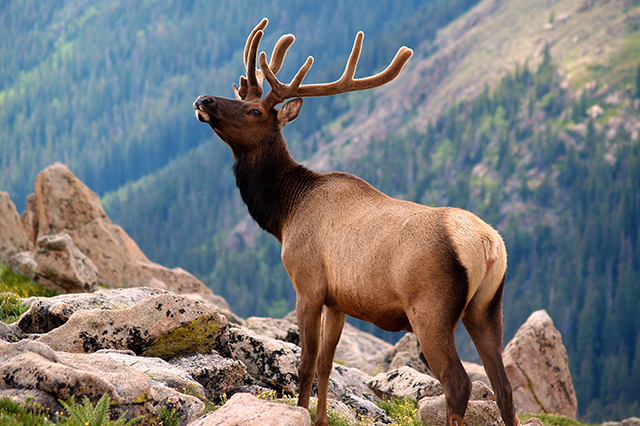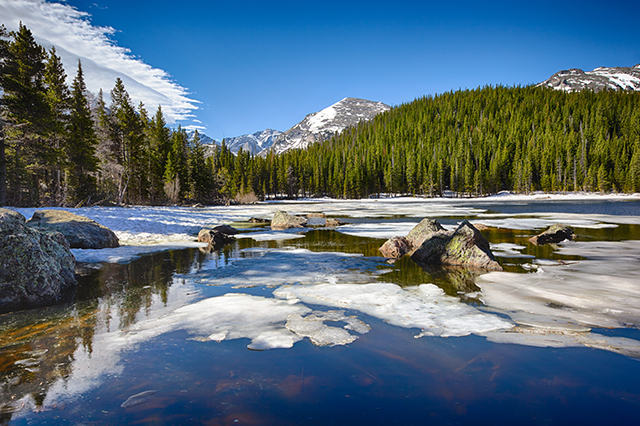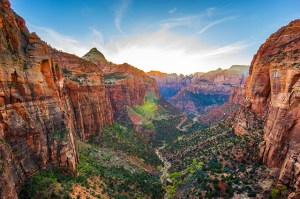Is the park open year-round?
Yes, Rocky Mountain National Park is open all year. Some roads and facilities are closed or limited during the offseason.
Where is the park located?
Rocky Mountain National Park is located in northeast Colorado, between Estes Park and Grand Lake.
How big is the park?
The park covers approximately 415 square miles.
How do I get around in the park?
Most visitors drive their own cars and campers into the park. In addition, the park offers a free shuttle bus service along Bear Lake Road.
What activities are available?
Some of the popular activities in Rocky Mountain National Park include:
- Hiking: The park contains over 355 miles of trails to explore. Whether visitors are seeking a short walk or a day hike, Rocky Mountain National Park offers a wide variety of experiences. Wilderness camping is allowed, with a permit, so visitors can plan multiday hikes.
- Scenic drives: The park’s roads lead visitors through its diverse terrain – from meadows and aspen groves up to the subalpine forest to the 12,000-foot mountain peaks.
- Wildlife viewing: Rocky Mountain National Park is known for its wildlife, including the regal elk, the majestic bighorn sheep, and graceful mule deer, as well as over 280 species of birds.
- Photography: From the wide range of fauna to the breathtaking landscapes, Rocky Mountain National Park provides nature photographers with a vast outdoor studio. Whether from the paved roads or a backcountry trail, photographers can find outstanding shots throughout the park.
- Horseback riding: The park holds two stables – Glacier Creek and Moraine Park – and several more can be found in the surrounding area that are permitted to bring riders into the park.
- Fishing: Rocky Mountain National Park has more than fifty lakes and numerous streams in which visitors can sport fish. A state fishing license is required, and some regulation must be followed.

Are pets allowed?
Pets are permitted in campgrounds (not wilderness campsites), on paved roads, and in parking lots. They are not allowed on trails or in the wilderness.
Is the park accessible?
Several trails in the park are accessible, including Bear Lake Trail, Coyote Valley Trail, Lily Lake Trail and the Sprague Lake Trail. In addition, many facilities, such as visitor centers, overlooks and restrooms, are accessible.
What accommodations are available?
While there are no lodging facilities within Rocky Mountain National Park itself, the neighboring communities have numerous accommodations ranging from high-end hotels to less expensive motels. The park does have several campgrounds with spaces for tents and RVs as well as backcountry camping sites. The surrounding area also has multiple private campgrounds with varying facilities.
Are there restaurants in the park?
Rocky Mountain National Park has one dining facility, the Trail Ridge Store, which offers a café and coffee bar from late May until early October. Numerous restaurants and grocery stores can be found in the towns outside the park.
What are the most popular areas of the park?
- Trail Ridge Road: This forty-eight-mile drive between Estes Park and Grand Lake winds through the park’s forests and tundra, with eleven miles of the road being above the tree line. Opportunities to view the park’s wildlife are abundant, and the scenic views are spectacular. Though it doesn’t take long to drive the entire stretch, it recommended that visitors allot at least half a day to enjoy this road.
- Old Fall River Road: For those who don’t find the Trail Ridge Road exhilarating enough, the eleven-mile-long Old Fall River Road might do the trick. When opened in 1920, this road was the first to offer access to Rocky Mountain National Park’s high country. The gravel surface, hairpin turns, and steep grade make this a slow-going drive, but one worth the struggle due to the outstanding scenery and close-up wildlife viewing in the area.
- Kawuneeche Valley: This valley on the west side of the park is filled with hiking trails, campgrounds, and chances to fish in the Colorado River. For visitors with an interest in history, the Holzwarth Historic Site offers a glimpse into Rocky Mountain life from a century ago.
- Bear Lake: This area on the west side of the park has beautiful scenery and several hiking trails and can be accessed by the free shuttle bus during the summer. During the winter, the lake freezes, creating a cold-weather destination for cross-country skiers and snow tubers.
Which national park would you like to visit most? Is Rocky Mountain National Park on your list? Tell us in the comments.













